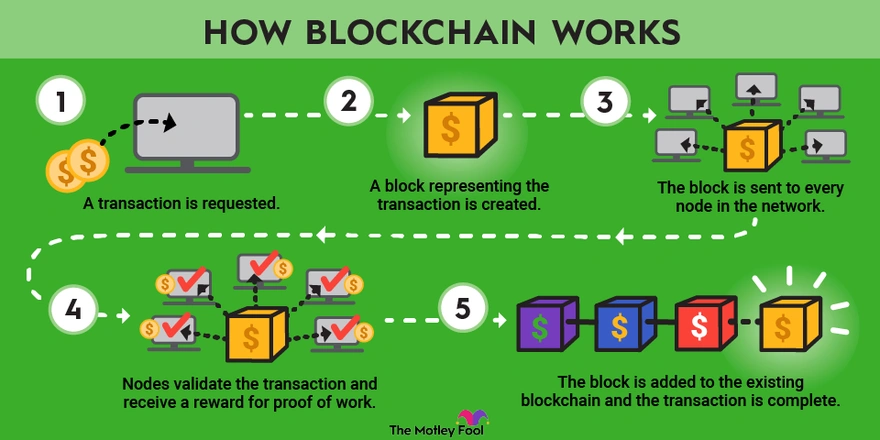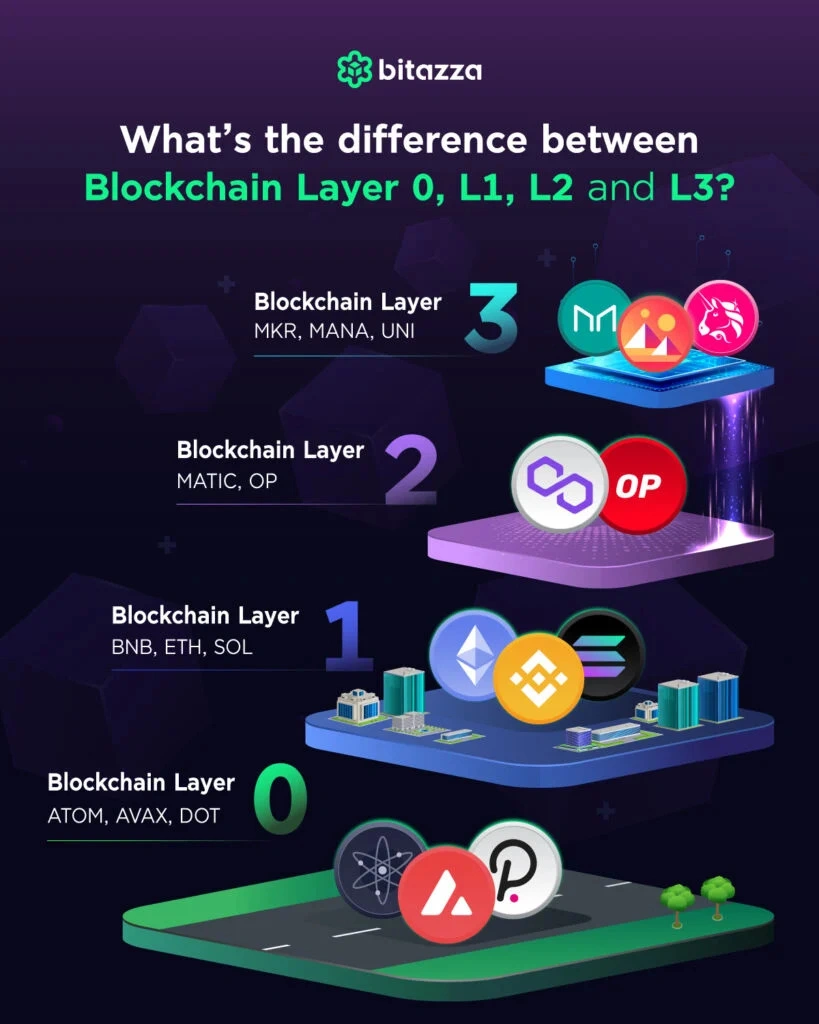Introduction: Why Blockchain Needs Layers
The phrase “layer 1 vs layer 2 blockchain” often pops up when talking about blockchain performance and scalability. If you’re new to the field, the terminology may seem technical—but at its core, it’s a way of organizing how blockchains work and improve over time.
In simple terms, Layer 1 and Layer 2 refer to different levels of blockchain architecture. Each layer serves a purpose, from processing basic transactions to solving the speed and cost issues that plague popular chains like Bitcoin and Ethereum.
This article offers a beginner-level breakdown of these layers, explaining what they are, how they function, and why the blockchain ecosystem needs both.
What Is a Blockchain, Briefly?

Credit from The Motley Fool
Before we dive into layers, let’s understand what a blockchain is. A blockchain is a distributed digital ledger—a kind of database—that stores information across a network of computers rather than on a central server.
Each transaction is permanently recorded in a block, linked together in sequence, and verified by a decentralized consensus mechanism. It’s this design that ensures security, transparency, and trust without needing a central authority like a bank or government.
Why Blockchain Architecture Is Layered
To handle more complex demands—such as scalability, faster transactions, and broader user interaction—blockchain systems have adopted a layered structure. This layered architecture helps separate different functions for clarity, performance, and easier upgrades.
Typical blockchain stack includes:
- Layer 0: Connects different blockchains.
- Layer 1: The main blockchain network (e.g., Ethereum, Bitcoin).
- Layer 2: Scalability solutions that operate on top of Layer 1.
- Layer 3: Front-end user applications like wallets and dApps.
In this guide, we focus mainly on Layer 1 and Layer 2.
Layer 1: The Core Blockchain Network

Credit from Pintu
Layer 1 refers to the primary blockchain protocol—the base network where data is stored and consensus happens. It’s where new blocks are created, transactions are validated, and smart contracts are deployed.
Examples of Layer 1 Blockchains:
- Bitcoin – Focuses on peer-to-peer transactions and security.
- Ethereum – Supports decentralized apps and smart contracts.
- Cardano – Known for a research-driven approach and energy efficiency.
- Solana – Designed for speed and low fees.
What Layer 1 Handles:
- Recording all transactions permanently on the blockchain.
- Maintaining the security of the network.
- Running decentralized applications (in chains like Ethereum).
- Using consensus algorithms (e.g., Proof of Work or Proof of Stake) to verify data.
Limitations:
While Layer 1 ensures security and decentralization, it struggles with performance at scale. As more users join the network, transaction speed slows and fees increase, especially during peak periods. Ethereum’s average gas fees can rise dramatically during NFT drops or DeFi surges.
Layer 2: Enhancing Performance Without Sacrificing Security

Credit from KvaPay
Layer 2 solutions are protocols or frameworks built atop Layer 1 chains. Their goal is to process transactions faster and cheaper by handling much of the computation off-chain—before reporting back to the main chain.
How It Works:
- A large number of transactions are processed off the Layer 1 blockchain.
- A summary or proof of these transactions is submitted back to Layer 1.
- The Layer 1 chain serves as the final settlement and security layer.
Examples of Layer 2 Solutions:
- Lightning Network – Speeds up Bitcoin transactions using payment channels.
- Arbitrum and Optimism – Ethereum rollups that batch transactions.
- zkSync – A zero-knowledge proof-based rollup offering scalability and privacy.
Benefits of Layer 2:
- Lower Fees: Offloading computation reduces gas costs.
- Higher Speed: Transactions can be confirmed in seconds.
- Scalability: Allows blockchain apps to support more users simultaneously.
Unlike Layer 1 upgrades, Layer 2 protocols can be built independently, often with more flexibility and without needing hard forks.
Layer 1 vs Layer 2 Blockchain: A Real-World Analogy
Think of Layer 1 as a busy highway. Everyone is driving on the same lanes, and when traffic builds up, everything slows down.
Layer 2 adds express lanes or side roads that take pressure off the main highway. These side roads are still connected to the main network but handle transactions more efficiently, checking back in only when necessary.
Why Layer 1 and Layer 2 Are Both Essential
Blockchain developers and users rely on the strengths of both layers to make the technology usable on a wide scale.
- Layer 1 provides the trusted foundation. It stores data securely and maintains decentralization.
- Layer 2 solves performance problems. It makes transactions fast, affordable, and scalable.
Together, they address the blockchain trilemma—the difficulty of achieving decentralization, security, and scalability simultaneously.
Table: Comparing Layer 1 and Layer 2 Blockchains
| Layer | Main Role | Performance | Security | Examples |
|---|---|---|---|---|
| Layer 1 | Core blockchain layer (data, consensus) | Slower, limited scalability | High (native) | Bitcoin, Ethereum, Solana |
| Layer 2 | Off-chain scaling and processing | High throughput, low fees | Relies on Layer 1 | Lightning, Arbitrum, zkSync |
Layer 1 vs Layer 2 Blockchain: Additional Layers for Reference
While not the focus here, Layers 0 and 3 also play important roles in blockchain ecosystems.
- Layer 0: Projects like Polkadot and Cosmos allow multiple blockchains to interact and share data. They serve as the foundational network layers.
- Layer 3: Tools like MetaMask, Uniswap, or OpenSea operate on the front-end, connecting users to Layer 1 or 2 without requiring technical knowledge.
These layers complete the broader blockchain structure, allowing developers to build apps, users to interact easily, and systems to connect across chains.
What’s Next for Blockchain Layers?
The future will likely see even greater reliance on Layer 2 innovations. With Ethereum’s long-term “rollup-centric” roadmap, many decentralized applications are moving to Layer 2 by default.
Also, more chains are exploring modular architectures—where each layer specializes in one task, such as data availability, execution, or settlement. This trend suggests that rather than trying to do everything on Layer 1, blockchains will become ecosystems of specialized layers working together.
Conclusion: Understanding Layer 1 vs Layer 2 Blockchain
For anyone entering the blockchain space, understanding the roles of Layer 1 vs Layer 2 blockchain is critical. Layer 1 forms the reliable core, ensuring data is secure and tamper-proof. Layer 2 adds agility, speed, and cost-efficiency—making mass adoption feasible.
As decentralized technology matures, these two layers will remain central to the infrastructure that powers everything from cryptocurrencies to decentralized finance and digital identity.
Whether you’re exploring crypto investment, building a dApp, or simply curious about blockchain, this layered perspective will help you make sense of where the technology is heading—and how each layer contributes to the big picture.



